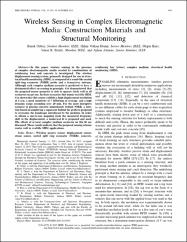| dc.contributor.author | Ozbey, Burak | |
| dc.contributor.author | Demir, Hilmi Volkan | |
| dc.contributor.author | Kurc, Ozgur | |
| dc.contributor.author | Erturk, Vakur B. | |
| dc.contributor.author | Altintas, Ayhan | |
| dc.date.accessioned | 2020-02-04T08:14:36Z | |
| dc.date.available | 2020-02-04T08:14:36Z | |
| dc.date.issued | 2015 | en_US |
| dc.identifier.issn | 1530-437X | |
| dc.identifier.other | 1558-1748 | |
| dc.identifier.other | 10.1109/JSEN.2015.2441555 | |
| dc.identifier.uri | https://hdl.handle.net/20.500.12573/113 | |
| dc.description | This work was supported by the Scientific and Technological Research Council of Turkey (TUBITAK) through Elektrik Elektronik ve Enformatik Arastirma Grubu (EEEAG) under Grant no: 112E255. The work of H. V. Demir was supported in part by the European Science Foundation through the European Young Investigator Awards, and in part by the Turkish National Academy of Sciences. The associate editor coordinating the review of this paper and approving it for publication was Dr. Stefan J. Rupitsch. | en_US |
| dc.description.abstract | In this paper, wireless sensing in the presence of complex electromagnetic media created by combinations of reinforcing bars and concrete is investigated. The wireless displacement sensing system, primarily designed for use in structural health monitoring (SHM), is composed of a comb-like nested split-ring resonator (NSRR) probe and a transceiver antenna. Although each complex medium scenario is predicted to have a detrimental effect on sensing in principle, it is demonstrated that the proposed sensor geometry is able to operate fairly well in all scenarios except one. In these scenarios that mimic real-life SHM, it is shown that this sensor exhibits a high displacement resolution of 1 mu m, a good sensitivity of 7 MHz/mm in average, and a high dynamic range extending over 20 mm. For the most disruptive scenario of placing concrete immediately behind NSRR, a solution based on employing a separator behind the probe is proposed to overcome the handicaps introduced by the medium. In order to obtain a one-to-one mapping from the measured frequency shift to the displacement, a numerical fit is proposed and used. The effects of several complex medium scenarios on this fit are discussed. These results indicate that the proposed sensing scheme works well in real-life SHM applications. | en_US |
| dc.description.sponsorship | Turkiye Bilimsel ve Teknolojik Arastirma Kurumu (TUBITAK) 112E255 European Science Foundation (ESF) Turkish Academy of Sciences | en_US |
| dc.language.iso | eng | en_US |
| dc.publisher | IEEE-INST ELECTRICAL ELECTRONICS ENGINEERS INC, 445 HOES LANE, PISCATAWAY, NJ 08855-4141 USA | en_US |
| dc.relation.ispartofseries | Volume: 15; | |
| dc.relation.ispartofseries | Issue: 10; | |
| dc.relation.ispartofseries | Pages: 5545-5554; | |
| dc.rights | info:eu-repo/semantics/openAccess | en_US |
| dc.subject | Wireless passive sensor | en_US |
| dc.subject | displacement sensor | en_US |
| dc.subject | strain sensor | en_US |
| dc.subject | nested split ring resonator (NSRR) | en_US |
| dc.subject | concrete | en_US |
| dc.subject | reinforcing bar | en_US |
| dc.subject | complex medium | en_US |
| dc.subject | structural health monitoring (SHM) | en_US |
| dc.title | Wireless Sensing in Complex Electromagnetic Media: Construction Materials and Structural Monitoring | en_US |
| dc.type | article | en_US |
| dc.contributor.department | AGÜ, Mühendislik Fakültesi, Elektrik & Elektronik Mühendisliği Bölümü | en_US |
| dc.contributor.institutionauthor | | |
| dc.identifier.doi | 10.1109/JSEN.2015.2441555 | |
| dc.relation.publicationcategory | Makale - Uluslararası Hakemli Dergi - Kurum Öğretim Elemanı | en_US |


















